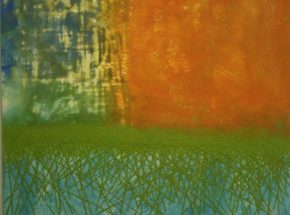

Take a step. Take another. Watch yourself. You’re on shifting ground. The ground is soft, moist, forgiving, but hidden and uneven. Ankle-twisting. You’re on a path, a path through my latest body of work, in a manner of speaking. Actually, you’re on a path in the woods, in the foothills of the Catskills, on a gentle ridge overlooking a small valley. Lately the path has become a fresh carpet of colors and smells and sounds-crunching, tumbling, cooked pumpkin pie-colored rotting leaves. Look behind you.
Across the small valley, through the trees, the horizon drifts up and down, separating the fuzzy blue browns of barren trees from a tawny cream sky. Black Bark Cherry trees interrupt your vista, shooting skyward almost from your nose, their dark branches running toward the sky like ribbons of black bean soup. Lots of undisciplined foliage clutters the view. Beech trees grow in groups and fill your scene with bark skin of light green and blue grays, with wobbly meandering limbs pulsating and curving like African elephant trunks. Look down. Ferns choke the path. They’re in the middle of turning from rambunctious bright blue greens to effete amber yellows. The ground and woods are outrageously colorful. Of course they are! Its mid- October in New York! What did you expect, monochrome?!
This environment that feeds the bulk of my painting is often too complex, too rich. It’s effulgent and overwhelming. Chaotic. In fact, I wouldn’t mind a little more monochrome. But that’s what imagination is for. It helps clarify and simplify, just like the winter snows that are coming next month to
cover up this path we’re on. Over the past 25 years I’ve enjoyed the challenge of re-organizing this physical chaos, of channeling and corralling this outdoor experience, of inventing some sort of contemporary human-made symbolic equivalence. In the art studio process of wrestling with memory and re-materializing sensation, things tend to change quite a bit, from the actual blizzard of colors, textures, and smells, to refined pigments and various mediums (linseed oil, damar resin, turpentine) applied to stretched canvas. These materials, manipulated with animal hair on sticks (paint brushes), enable some kind of strange but fundamental translation of human experience into paint on a surface. The results are always imperfect, never all-encompassing. Hopefully they convey a metaphor that communicates and fascinates.
Website
http://www.julianhatton.net
